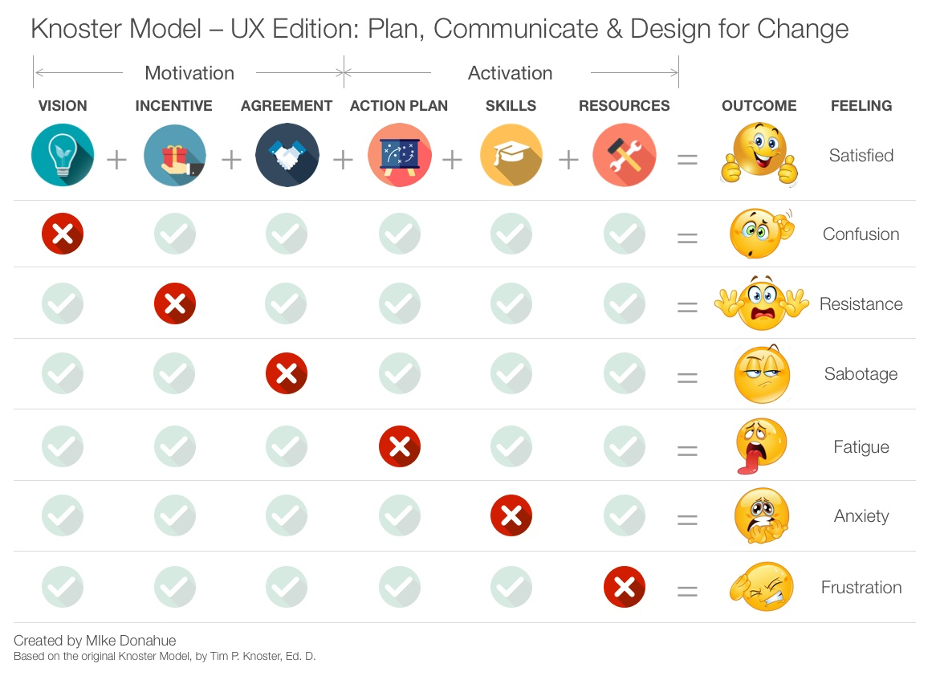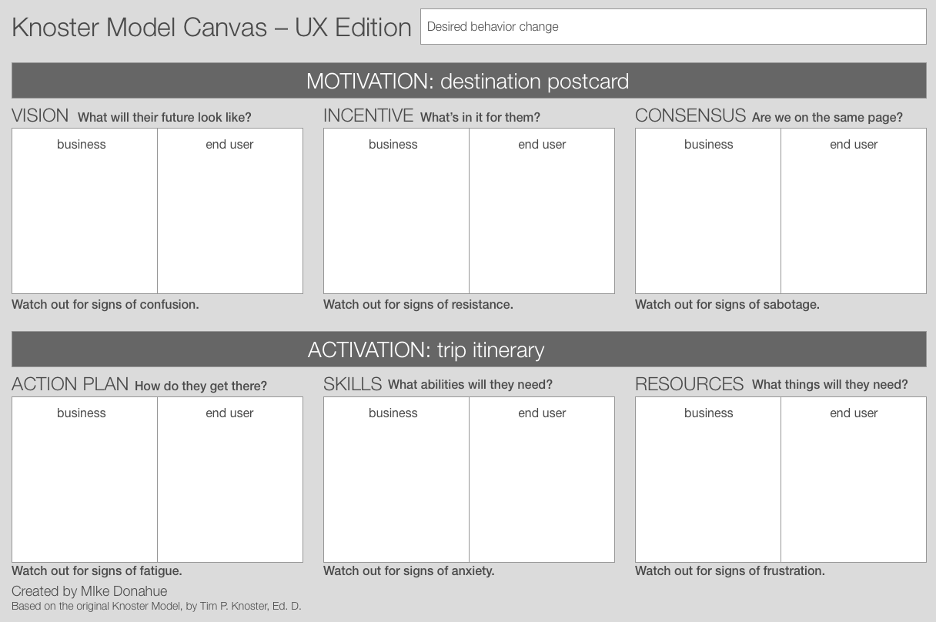Every experience we have changes us. Every experience we design changes others. Change is inevitable and unavoidable. If this is true, why do people hate or fear change?
For starters, change takes effort (effort = pain). Second, people fear the unknown (unknown = uncertainty). We want to know that there’s a payoff from any effort we put in. We need to remember that people will do more to avoid pain than they will ever do to gain pleasure.
Designers need a reliable, proven method to create and communicate desirable change for end users and business. We need an effective way to show how much gain they will get while we minimize their pain. The Knoster Model for Managing Complex Change helps UX designers do just this.
- It gives us a framework to shape our communications to end users and stakeholders to motivate and activate the change we desire
- It gives us a way to pinpoint where the experience is lacking when we get unexpected or undesirable reactions
- It fits within existing processes to inform design and marketing
The Short Story of the Knoster Model
The Knoster Model was created by Tim P. Knoster, Ed.D., professor at the McDowell Institute for Teacher Excellence in Positive Behavior Support in the College of Education at Bloomsburg University of Pennsylvania. The model is the result of years of rigorous behavioral science research and testing. It has been proven effective in creating positive behavior change in students with learning disabilities. While its origin and primary use have been in education, its principles are applicable anywhere change is needed, that includes UX design.
How the Knoster Model Works
The Knoster Model defines six elements that we must address to affect desired behavior change — Vision, Incentive, Agreement, Action Plan, Skills, and Resources. For the purpose of UX design, we can bucket each into one of two distinct categories — Motivation or Activation.

Addressing all elements in the model increases our likelihood to achieve the desired change. Failing to deliver on any of the elements will result in predictable reactions from our end users and stakeholders. Reactions that help us pinpoint our experience strategy falls short. All we need to do is pay close attention. Your ability to recognize the reactions will impact your ability to spot where your change plan is falling apart.
How it fits with existing UX process
It’s common UX practice to map out the user’s journeys. The metaphor of the journey helps us see how the Knoster Model fits within our existing UX practices. Like a real-life journey, an experience journey requires two things for success. First, we need to know the destination and the reason for going. A destination postcard1 if you will. Second, we need to know how to get to the destination and what we need to bring. Think of this as a trip itinerary.
- Destination postcard = motivation, the fuel, and purpose for the journey.
- Trip itinerary = activation, the GPS, vehicle, and snacks for the journey.
Motivation – the Destination Postcard: Vision, Incentive, Agreement
The first thing we need to do when designing for change is to paint the picture of what change looks like, and give end users or stakeholders a reason to care. The more meaningful the change, the more likely the change. It begins with a crystal clear vision.
Vision – Does this make sense to me?
Clarity and resonance are key. Paint an image of what the world will look like when the experience is done. Show your audience who they will become and how they will benefit. By “audience” this refers to both end users and stakeholders. The goal of the Vision is to inspire desire. (Don’t confuse a vision with a mission statement.)
Take the Worx Landroid for example, an automated lawnmower. It’s like a Roomba for mowing your yard. You sit back drinking lemonade in the shade while your yard robot mows the lawn.

That’s a destination postcard that is easy to picture in your mind. It’s a clear and meaningful vision. This where change begins. Take your time to get this right. Ask yourself, what is the most inspiring destination you can envision for your audience?

Confusion is a signal that the vision is unclear or meaningless to your audience. In other words, we failed to inspire desire.
Incentive – What’s in it for me?
Obvious and significant are key. People need to know with certainty how changing will benefit them before they commit to the effort. The incentive (reward) must far outweigh the perceived effort (pain) of making the change. The goals of the Incentive are to deliver actual and significant value.
The benefits of the Landroid are obvious and significant. Turn it on and let it go. It’s battery-powered so there’s no need for getting, storing, pouring, or spilling gasoline. It’s quiet compared to a gas mower. It reduces your carbon footprint. It might even make your neighbors jealous as they fight to pull-start their mower and get ready to push it around their yard in the summer heat for the next hour. There are a lot of benefits that are geared towards overcoming the pain of the price.

Resistance is a signal that the incentive is obscured or insignificant to your audience. Another possibility is that the change favors you more than the audience you’re asking to change.
Consensus – Do I agree?
Alignment and agreement are key. Whether it’s end users or stakeholders, you need adoption/buy-in and intended use/support for your design. Without consensus, you will run into undesirable behavior and sabotage. The goals of Consensus are to create real alignment and agreement on use and outcomes.
With end users you’ll know you have real consensus when they adopt and use your designs as intended. If they’re using your product in unintended ways it either means that they didn’t understand your vision, or they had a vision of their own. Think about what social platforms say their intended use is, and then look at how they’re being used. If adoption is low it’s because they don’t see how the gain outweighs the pain of change. Think about the pain of switching from an iOS to an Android cellphone, or the other way.
With stakeholders, you’ll know you have real consensus when they “buy-in” and support your intended design. If they don’t support the intended design, again, it’s either because they don’t understand the vision or they have one of their own. In some cases this may mean you need to reframe your vision so they understand, in others, you will want to consider their perspective and figure out if your vision needs revision. If they don’t buy in, again it’s because they see what’s in it for them. Take a close look at how you’re measuring success to make sure it aligns with how they measure success. how are they rewarded for success?

Sabotage, intentional or not, is a sign of false alignment or agreement from your audience. By sabotage I mean that end users and stakeholders behavior are at odds with your goals and can obstruct success. Sad fact, real consensus happens far less than we care to believe.
Activation – Trip Itinerary: Action Plan, Skills, Resources
Motivation gets the wheels in motion but activation keeps them turning in the right direction. Activation relates to the usable aspects of the experience journey.
Action Plan – How do I get there?
Obvious and directional are key. People know where they are. If your Vision inspires them, they know where they want to go. What they need are clear directions to the new destination. The goal of the Action Plan is to show people how to get from where they are to where they want or need to go.
When Apple released the first iPod in October 2001 they had a plan. It included releasing iTunes in January of 2001 and working deals with record companies to sell their music through iTunes. This was the internal plan they needed to execute before bringing the iPod to market. When they released the iPod they launched a campaign that inspired desire, and let people know when, where, and how to get the iPod. The rest is history. Give people clear signals about the steps they need to take, don’t make them figure it out. They might not.

Fatigue is a sign the Action Plan is incomplete or unclear to your audience. False starts and wasted effort can kill motivation.
Skills – Do I have what it takes?
Ability for all is key. The designer’s job is to mitigate or eliminate the limitations and enhance the capabilities of their audience. The goal of Skills is to make sure the audience has the ability to complete the experience.
There are two paths to consider when addressing skills. The first is to reduce the amount of skill required. Apple reduced the skill (mental and physical effort)2 it took to organize, load, and play your music with the iPod compared to other MP3 players of the time.
The second, less desirable but often necessary, way is to teach people the skills they need. As time moved on and the iPod and iTunes evolved in capabilities and technology, so did the complexity of completing various tasks. Apple offers a robust help center filled with “how-to” instructions. Whatever instructions they don’t have, there are plenty of videos on YouTube to help build skills. Reduce when you can, teach when you can’t.

Anxiety is a sign that people are concerned they are incapable of completing the experience. People hate to feel incompetent, it destroys their basic desire for a sense of autonomy.
Resources – Do I have what I need?
More is great, but enough is key. This is the most straight forward of the six elements of change. Doctors and nurses need PPEs (personal protective equipment), teachers need classroom supplies, students need books, and so on. Everybody needs time and money. The goal of Resources is to ensure people have what they need to succeed.
Imagine you’re camped outside the Apple store for three days waiting to get the first iPod. You’re the first in line when the door opens. You go in and give the Apple Genius $400 for the iPod, and home you go. When you get there you unbox the iPod marveling at its beautiful design. The crazy “click wheel” is like nothing else you’ve ever seen. You are ecstatic. You go to connect the iPod to your Mac or PC only to discover that the post on your computer isn’t compatible with the included cable.
Lack of even a single resource can bring a journey to an abrupt and frustrating end. You had the motivation, the plan, and the skills, but you lacked the resources. Make sure that your audience has all the resources they need.

Frustration is a sign that people lack the external necessities to complete the experience. Nothing worse than getting excited about something, beginning the journey, only to discover you’re missing a single resource required to accomplish your goal.
The Knoster Model Canvas: UX Edition
I created, and use, this canvas to flesh out my plan for communicating the new experience to end users and stakeholders.

Here are some starter questions you’ll want to get answered for each of the elements. Make sure your answers are grounded in reliable, unbiased research.
- Vision – What does this experience ask the audience to become.
- Incentive – What’s in it for (end user/stakeholder/business/you)
- Consensus – How will I know if everyone is on the same page?
- Action Plan – What steps are required to complete the journey?
- Skills – What capabilities must your audience possess for success?
- Resources – What “things” are needed to complete the journey?
Becoming an Agent of Positive Change
Change is inevitable and unavoidable. As the designer, you have the responsibility and opportunity to make sure the change is beneficial and meaningful to your end users and business stakeholders.
References
(1) Switch: How to change things when change is hard., by Chip and Dan Heath is the source of the destination postcard. A great book for any designer that wants to become an agent of positive change.
(2) Fogg Behavioral Model list Ability factors affect people’s desire to take action – mental effort, physical effort, time, money, social deviance, and non-routine. When an experience requires more of any of these factors it reduces the likelihood that people will take action.